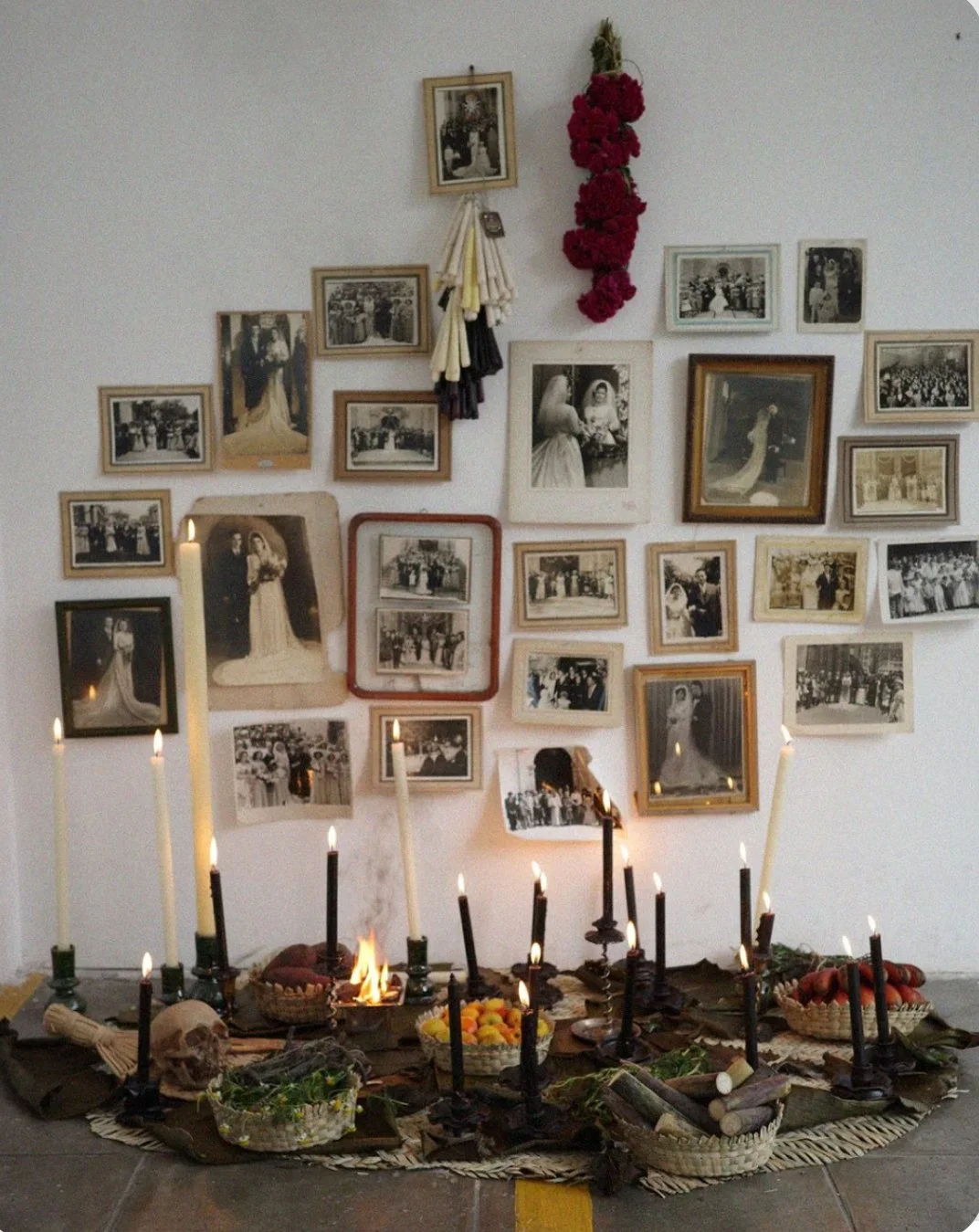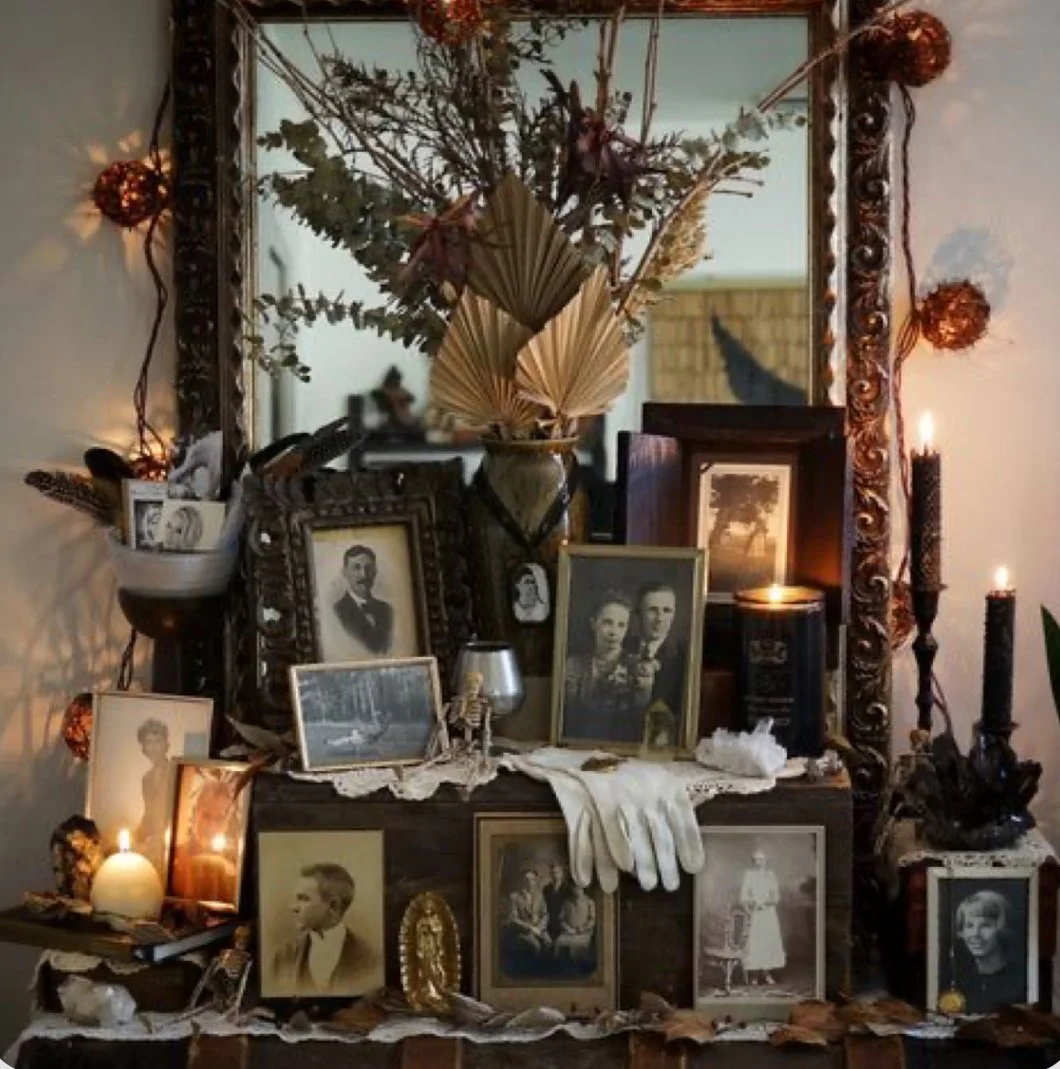How to create your own Altar for Autumn and your Ancestors.
Vesta herself, the Roman goddess of hearth and home, took care of the eternal flame within a temple, who’s ruins are still visible in Rome. However, domestically Vesta was enshrined in most homes. Dwellers would give thanks to Vesta for warmth, nourishment, protection and peace and would make offerings to Vesta of wine, salt, food and incense.
Having a place to direct thanks and prayer and intention and manifestation is a practice that humans have always followed.
During lock down, I converted my small bedroom into a temple of prayer and direction. But a temple doesn’t have to be a room or a building, it is simply a place holding. A small temple or altar is a reminder that we are not alone. That our prayers and dreams and desires are valid and holy and they are heard and given to us by something higher than our own material beings, bodies and brains. They are direction.
Our own homes are physical representations of ourselves and what we bring into them we should do so with intention.
At this time of year, giving thanks to the harvest is a ritual our ancestors would have taken part in through the traditions of feasting, making offerings to the earth and lighting sacred fires. A good harvest could have meant the difference between life and death in past times.
I have different altars through out my home, to direct my intention and remind me of the larger forces of nature and history.
I am going to share how you can make two altars for this time of year. One is an ancestors altar and one is an autumn altar.
How to make an Autumn altar.
Step One
You first need to decide on a place for your altar. If you already have a space where you meditate or a place you pull cards and direct your intentions, you can use this space.
I have decided this year to build mine in the kitchen.. at the table where it can be present at the heart of the home as daily life unfolds.
Contain your altar, either on its own table or a tray on a larger table is a great idea. Some people use fabric to contain this space and you can chose something that appeals to you. I have a beautiful piece of fabric i use which has sentimental meaning, as the Uncle who returned with it as a gift from his travels has now passed.
Step Two
I always start with candles on my altars. Select a candle holder that represent the season to you, or something much loved. I am working with a snake candle holder this year, that represents the year of the snake and is a powerful symbol of transformation and femininity. But I also work with some beautiful candle holders that my friend Katie Ceramic Magpie has created.
Then select your candles. Candles are powerful things. Not only do they represent the fire element they connect us with the past, where light was only offered to us by firelight. Not by electric, not even by oil. Candles are said to be a light that can be seen in all realms. That all our ancestors will recognise the light of a flame.
Choosing a natural wax for your candles is a healthier and more authentic option for an altar. Paraffin wax is cheap and is derived from petrol chemicals. Burning a paraffin candle, especially with added scent releases strong and harmful toxins into your space. Personally i love beeswax candles. their beautiful yellow glow and air purifying benefits make them the more natural choice. They also give a much cleaner burn than other candles and last longer due to the higher melt point of beeswax. I also enjoy working with the energy of the bees who are magical creatures. Using their wax is a blessing.
You may also choose to use coloured candles for additional potency and meaning. Here is a run down of the candle colours and their supportive element..
· Natural beeswax – purity, tradition
· Black – protection
· Red – strength, passion, grounding
· Orange – creativity, joy
· Green – abundance, renewal
· Blue – peace, truth
· Yellow – clarity, optimism
· Pink – love, compassion
Id usually chose a larger pillar candle that has a longer burn time. Something that will last a longer part of the season. This candle will be the main source of light and the main and constant direction of my intention.
Ill then select smaller candles. I tend to use smaller taper candles in colours that relate to the season or the time or the intention. I also add in Vesta Living molded candles in shapes that resonate with me.
These smaller candles resonate with the short term. A particular meditation or intention I’m working on. A particular level of support that’s needed at the time.. which could change on a daily or a weekly basis.
For an autumn altar I’d use black for its protective elements and red and orange. The warmer base chakra colours. And the natural beeswax colour for my pillar.
Once you have your candles selected you can then begin to add in the other elements.
Step Three
Build your altar.
Adding sacred (to you) objects is how the altar finds its potency and purpose. Its doesn’t have to make sense to anyone else, what holds meaning to you is the important part. Its customary to honour the elements or call in the corners, evoking elemental spirits. This protects the space and roots the practise in nature. We can use this structure as a starting place for adding objects..
Fire – we cover this element with candles..
Earth – We will probably find most objects of our autumn altar here. You could add pine cones, acorns and autumn leaves. Pumpkins or gourds are harvested at this time of year and perfectly represent gratitude for the harvest and prosperity beyond.
Air – Can be represented by a feather or incense or poetry even, as this element is linked to the mind. A ceremonial sword or knife would also work. Bells, spoons, a fan and incense are perfect too.
Water – water its self or wine can be placed on the altar. I have a couldran which represtents the waters of life. A seashell or driftwood or naything you may find in the water.
You should work intuitively. Be guided by yourself.
There are other items you can use to add to your altar.
You can also add in crystals that are meaningful..
Crystals bring both beauty and meaning. For autumn, I like to work with:
· Tiger’s Eye – courage, focus
· Obsidian – protection
· Garnet – grounding, life-force
· Citrine – abundance, light
· Smoky Quartz – release, transformation
· Rose Quartz – love, remembrance
You can also have a bowl of food offerings. Sweets, or dried fruit work beautifully and if you work with physical statues of deities you can add those in too.
Incense doesnt just smell amazing… it ios there to cleanse the energy and allow you to drop into your mediations. I would always recommned using natural incense, Palo Santo, Sage, Francinsence, or even buring bay leaves or other herbs works well. I recommend burning incense before and after spending time at your altar.
Visually your altar can look however you want it to. You can create hight and levels. You can add as many objects or as few as you like. You might want to move things around. Let your altar look and feel in a way that is good to you.
The Ancestor Altar
Alongside the harvest altar, autumn is also the time to honour our ancestors. Across cultures, this season—when the veil between worlds feels thin—has always been a time of remembrance. From Samhain in Celtic tradition to All Souls’ Day in Christianity, autumn is a season of honouring those who came before us.
Creating the Space
Choose a quiet spot for your ancestor altar—somewhere you can pause, light a candle, and reflect. Unlike the harvest altar, which celebrates abundance, this altar is about memory, lineage, and continuity.
What to Include
· A candle: Light guides the way for our ancestors. A single flame is enough.
· Photographs or mementoes: Place pictures of loved ones who have passed, or small objects that belonged to them.
· Offerings: Traditional offerings include bread, wine, fruit, or favourite foods of those you honour. A small plate of food or a cup of tea left overnight can be a simple, moving act of remembrance.
· Seasonal plants: Marigolds, rosemary, bay, or ivy—plants often associated with memory and mourning.
· Symbols of connection: A family heirloom, a letter, or even a written note expressing your gratitude to those who came before.
This altar is a place to sit in quiet conversation with your lineage. You can speak aloud, offer thanks, or simply reflect. It does not need to be elaborate; what matters is sincerity.
Living with Altars
Both harvest and ancestor altars are meant to be living, breathing spaces. They are not static displays, but places to visit often. Light a candle each evening. Replace offerings as they fade. Add new objects as your intentions shift.
The altar is less about decoration and more about connection—connection to earth, to spirit, to the past and future.
As our ancestors lit fires to guide them through the darkening year, we too can light candles and gather symbols to remind us of what matters: gratitude for the harvest, honour for those who walked before us, and faith in the cycles that carry us forward.
An altar is, at heart, an act of devotion—to life itself.



